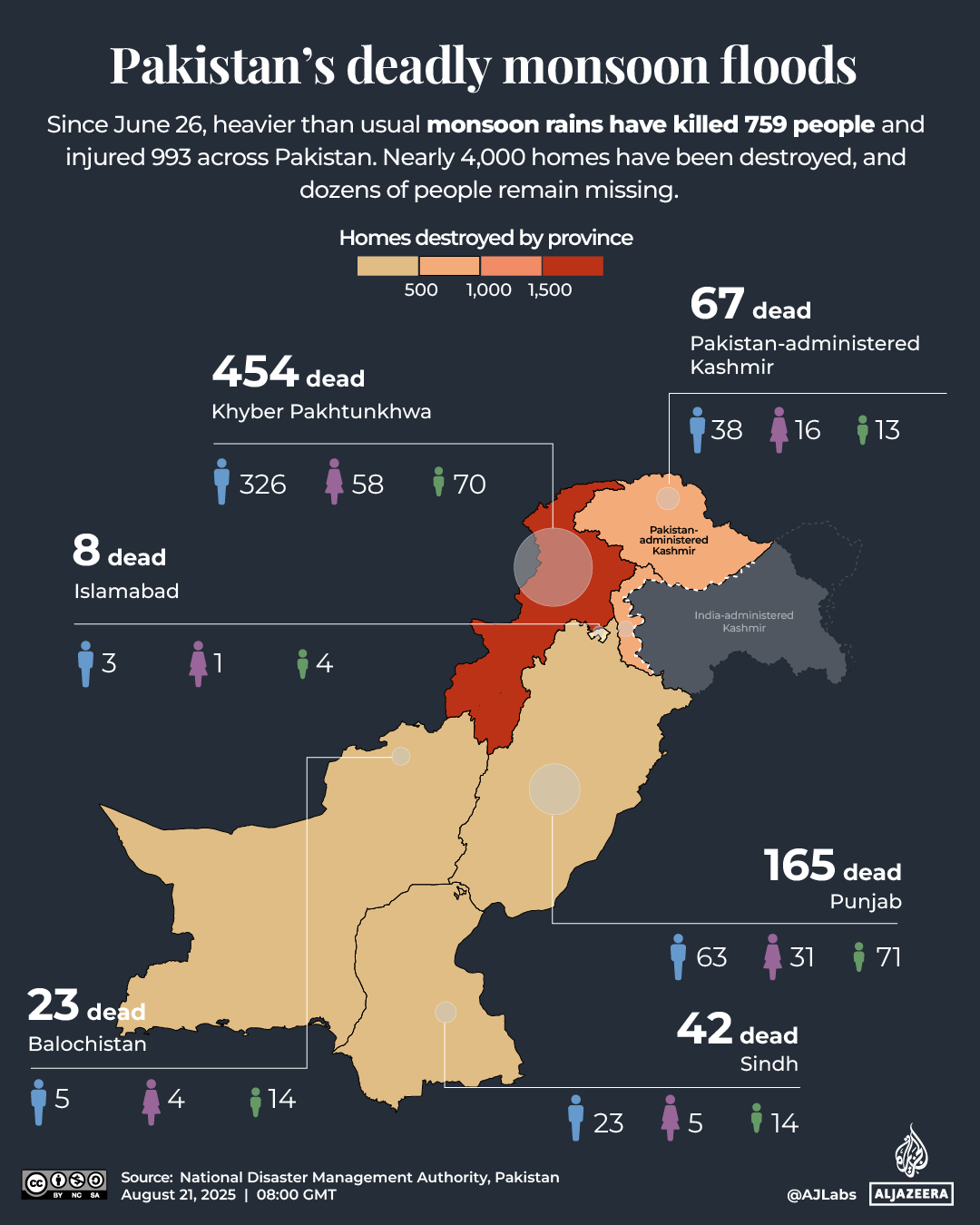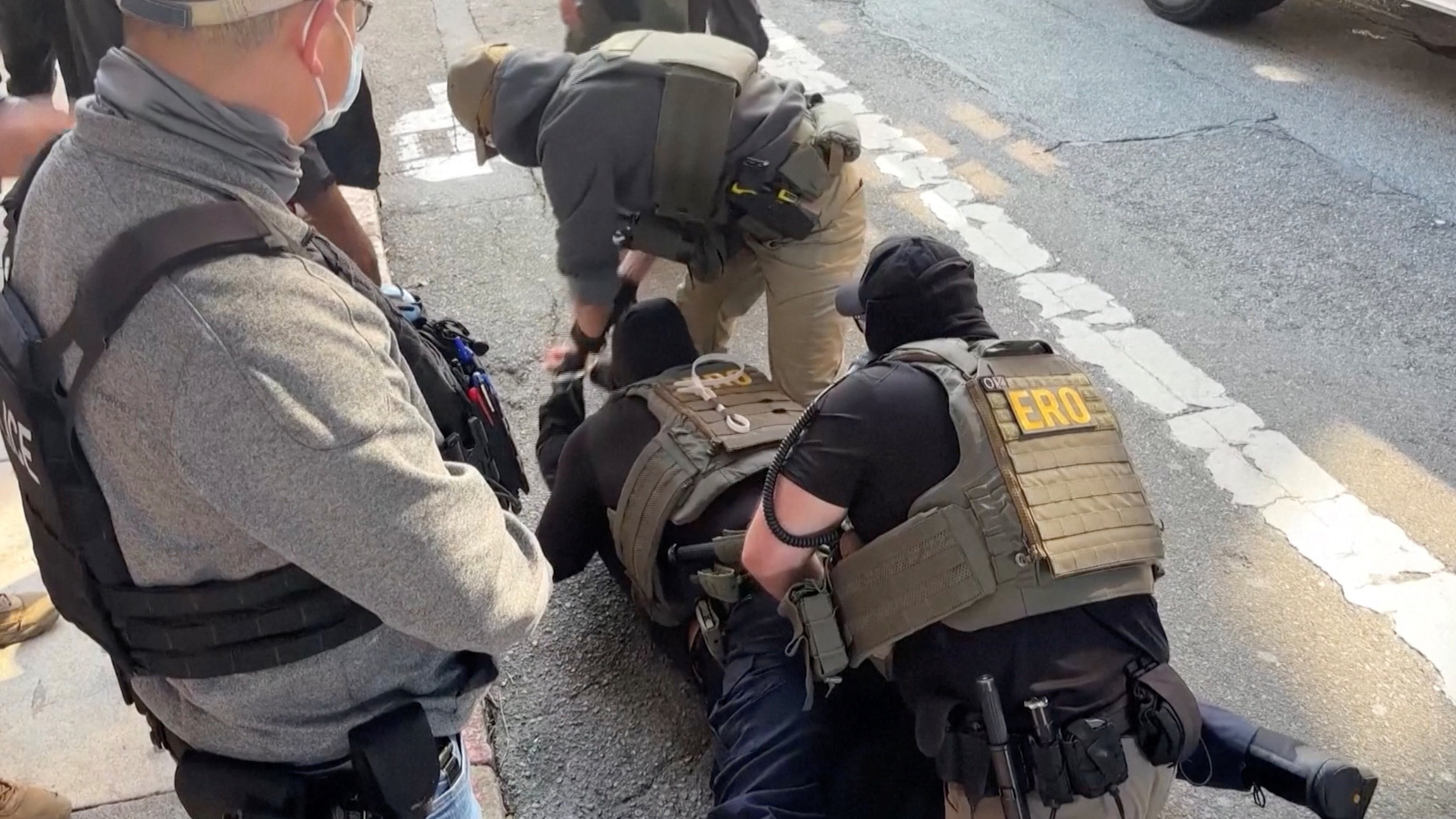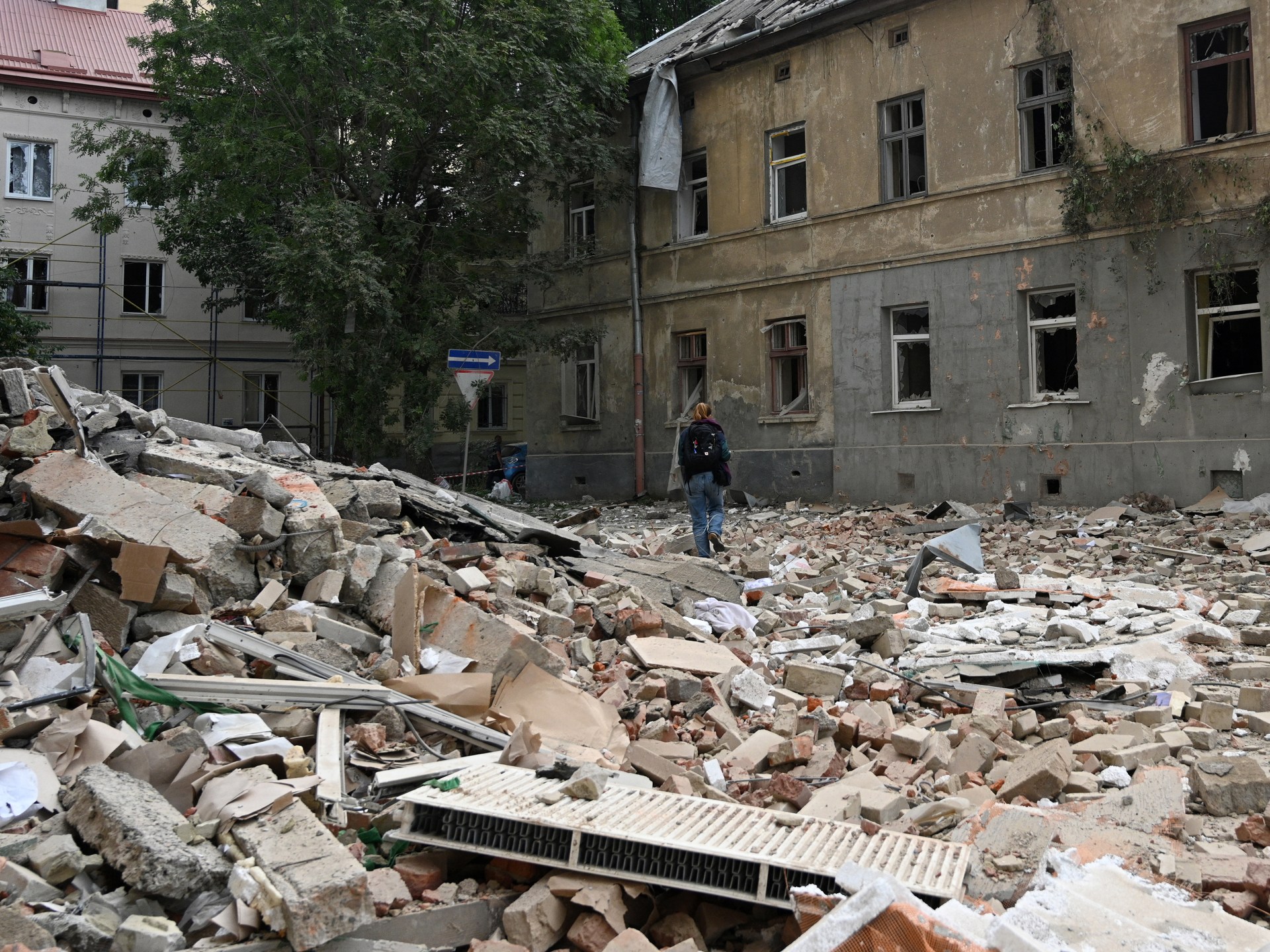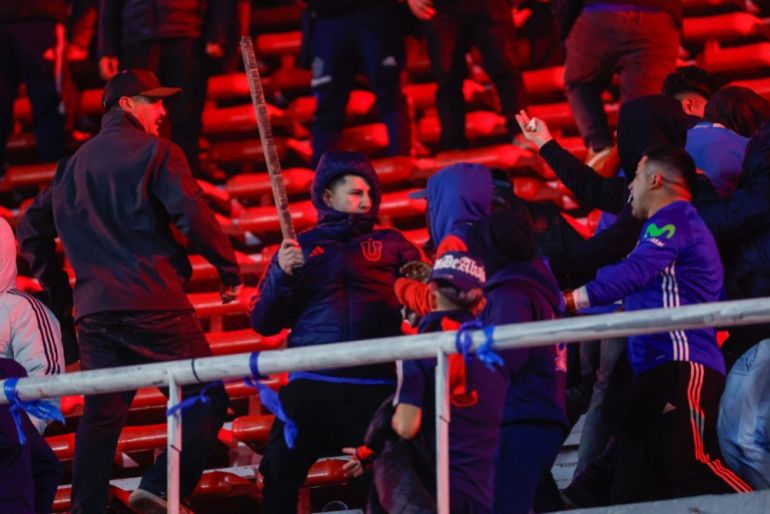Pakistan has been reeling from flooding triggered by torrential rains, with nearly 400 people killed since August 14.
On Wednesday, Karachi was inundated following a heavy downpour, paralysing the southern port city of 20 million people less than a week after deadly flash floods swept away villages in the northwestern province of Khyber Pakhtunkhwa.
More than 700 people have been killed in the flooding and landslides across the South Asian nation since June, with forecasters warning of further downpours until Saturday.
So why have floods in Pakistan been so intense, and what is the solution to the South Asian country’s flooding problem?
Where did it flood in Pakistan?
The Buner district in the Khyber Pakhtunkhwa province has been the worst hit, with more than 200 people killed and extensive damage to homes and public infrastructure across the northwestern mountainous province since August 14.
The Himalayan region of Gilgit-Baltistan, as well as Pakistan-administered Kashmir, was also affected.
Karachi, the capital of the southern Sindh province, was hit by floods after rainfall on Tuesday. Videos circulating on social media showed cars and motorbikes submerged in water.
How many people have died in the floods?
On Thursday, nine people died and 15 were injured across the country, according to the National Disaster Management Authority (NDMA). Seven of these deaths were in Khyber Pakhtunkhwa, while two were in Sindh.
On Wednesday, 41 people died and 11 people were injured across the country. At least 19 of these deaths were in Khyber Pakhtunkhwa, 11 deaths were in Sindh, and 11 deaths were reported in Gilgit-Baltistan.
Some 759 people have died, including 186 children, and 993 have been injured since the onset of the monsoon season in June. More than 4,000 houses have been damaged due to flooding in the same period.
What do rescue efforts look like?
The head of the NDMA, Lieutenant General Inam Haider Malik, said that more than 25,000 people had been rescued from flood-hit areas, Reuters reported on Wednesday.
The army and air force have also been pressed into action in rescue efforts.
On Wednesday, 2,300 people were treated in 14 active medical camps in Khyber Pakhtunkhwa, according to the NDMA. Relief items have also been distributed among those affected by the floods.
What is causing the floods in Pakistan?
While the exact cause of the floods is yet to be determined, several factors could have contributed to the deluge.
“While climate change plays a critical role in intensifying flooding events in Pakistan, other factors such as urbanisation, deforestation, inadequate infrastructure, and poor river management also contribute significantly,” Ayyoob Sharifi, a professor at Hiroshima University in Japan, told Al Jazeera.
Climate change
Sharifi told Al Jazeera that climate change is causing monsoon rainfall to intensify, resulting in more frequent extreme precipitation events.
A study co-authored by Sharifi and published in February this year, indicates that cities such as Lahore and Faisalabad could experience increased rainfall under certain scenarios, heightening the risk of urban flooding.
He added that rising temperatures allow the atmosphere to hold more moisture, leading to heavier downpours during storms. In northern Pakistan, these higher temperatures are also accelerating glacial melting, which increases the likelihood of glacial lake outburst floods (GLOFs). These are floods that occur when water is suddenly released from a glacial lake.
Earlier this month, a GLOF occurred in Pakistan’s northern region of Hunza, when the Shisper Glacier swelled the Hassanabad nullah, damaging infrastructure and destroying cultivable land, Dawn reported on August 8.
While Pakistan is responsible for less than 1 percent of global greenhouse gas emissions according to European Union data, the country bears the brunt of climate disaster, the country’s former Finance Minister Miftah Ismail told CNBC in 2022.
Heavy rain over a short period
Fahad Saeed, a climate scientist at the Berlin-based think tank, Climate Analytics, told Al Jazeera that the flooding was caused by higher-intensity rainfall. This means that there was a large amount of rain over a short period.
In Buner, more than 150mm (6 inches) of rain fell in just one hour on Friday morning.
In 2022, Pakistan endured its most severe monsoon season ever recorded, resulting in at least 1,700 deaths and causing an estimated $40bn in damage. Saeed said the 2022 floods were unexpected because of the areas they hit, ravaging arid or semiarid parts of northern Sindh that usually do not experience heavy rainfall.
However, rainfall this year has occurred within or around the region that normally experiences monsoon rain, he said. What is unusual this time is the sheer intensity of the rain.
Soil unable to absorb the rain in rural areas
Saeed explained that when there is rapid rainfall in a rural area over a short time, the soil does not get enough time to absorb the rainwater. “The rain doesn’t infiltrate into the soil, rather, it flows off the surface. It results in mudslides and soil erosion.”
This applies to rural areas in the northern parts of Khyber Pakhtunkhwa and parts of Gilgit-Baltistan.
“What happens is that normally, if you are living next to the rivers, your house is prone to get destroyed or inundated. But this time, what happened is that even if you are on the slopes of the mountain, the rainfall is so intense that because of the mudslide and the landslides, it destroyed the homes at the elevations,” Saeed explained.
Issues with the drainage system in urban areas
Karachi primarily relies on natural stormwater drains, or nullahs, for rainwater to be drained off.
Research shows that Karachi generates more than 20,000 tonnes of solid waste per day, and the nullahs are clogged by this rubbish.
During an event on urban flooding last year, hydrologist Sana Adnan pointed out that cleaning nullahs only before the monsoon season significantly contributes to flooded roads, emphasising that heavy rains can happen at any time of the year, not just during the monsoon, local outlet Dawn News reported.
Architect and planner Arif Hasan told Dawn in 2020 that due to the absence of a sustainable social housing policy, working-class families set up informal settlements across these nullahs. These informal settlements and formal developments use the nullahs for sewage disposal.
Hasan wrote that since the mid-1960s, Karachi’s waste disposal system has been set up for sewage to go into nullahs.
Rapid urbanisation and migration
Sharifi said that another reason behind urban flooding is that rapid and unplanned urbanisation reduces natural drainage and increases surface run-off, exacerbating flooding in cities like Karachi and Lahore.
Saeed added that cities are growing due to the rapid migration of people from rural areas into urban centres, and climate change might also cause this.
“Whenever somebody migrates from a rural to an urban area, they tend to move towards big cities like Lahore or Karachi,” Saeed said.
He explained that climate change can result in low crop yields, compromising the livelihoods of farmers in rural areas, leading them to move their families to cities.
“Once they reach the city, they are most likely to settle in informal settlements. Over time, they try to become part of that society. Meanwhile, city management struggles to provide necessary civic facilities, creating a kind of feedback loop.”
Deforestation and river management issues
“Loss of forest cover in upstream areas reduces the land’s ability to absorb water, increasing the volume of run-off into rivers,” Sharifi said.
Buner is mostly hilly, with steep slopes leading into narrow valleys. The area’s loose, easily eroded soil and ongoing deforestation make it especially prone to landslides and flash floods.
Sharifi added that the absence of green infrastructure such as parks, wetlands and permeable pavements also exacerbates flooding by removing natural systems that would otherwise help absorb and slow water flow, reducing the risk of flooding.
“Inefficient management of river systems, including the lack of proper embankments and flood control measures, contributes to riverine flooding.”
Limitations in early warning systems
The study that Sharifi co-authored identified limitations in the early warning systems which predict rainfall.
He explained that the currently used models often fail to capture regional and local climate nuances, leading to inaccuracies in projecting extreme precipitation events at smaller scales.
Sharifi added that most studies focus on large cities, leaving small cities underrepresented.
What measures can Pakistan take to mitigate flooding?
“Mitigating flooding in Pakistan requires a multi-faceted approach that addresses both structural and non-structural measures,” Sharifi said.
He explained that structural steps include building and maintaining drainage systems, reservoirs and restoring natural waterways.
Urban areas should use green infrastructure like permeable pavements and rain gardens to absorb water and prevent run-off. Urban planning must also manage land use to avoid building in flood-prone areas.
Non-structural measures include the latest early warning systems, better disaster preparedness, community education on flood risks and stronger disaster management coordination.
Saeed said that Pakistan is experiencing multiple facets of climate change impacts.
He said that addressing climate change calls for holistic, integrated planning across different departments.
“We can no longer afford to work in silos,” Saeed said, explaining that Pakistan has federal-level ministries for climate change, development, water, industry and agriculture.
Climate scientists, academics and other experts need to become a part of climate policymaking in the country, he said.
How is the current flood situation in Pakistan?
Rainwater accumulation has been cleared from the northwestern regions of Pakistan. However, infrastructure has sustained damage.
The Sindh Information Department made a series of posts on X on Wednesday saying that stormwater has been cleared from roads in multiple neighbourhoods in Karachi, including North Nazimabad. Safoora, Clifton and Liaquatabad.
Dawn reported on Wednesday that rainwater had accumulated in some roads near Karachi’s major I I Chundrigar Road.

Is more flooding expected in Pakistan?
Yes, the NDMA posted an emergency alert on X at about noon (07:18 GMT) saying that extremely heavy rainfall is expected in Sindh’s cities Karachi, Hyderabad, Thatta, Badin, Mirpurkhas, Sukkur and adjacent areas “within the next 12-24 hours”.
The NDMA added that there is a risk of more than 50 to 100mm of rainfall over a short period raising the risks of urban flooding in Karachi, Hyderabad, Sukkur and Mirpurkhas.
The NDMA added that Sindh’s rural regions Thatta, Badin, Jamshoro and Dadu are at risk of sudden flooding due to rising water levels in the Indus River and its tributaries. Low-lying regions may be inundated, with major highways and local roads potentially submerged, severely affecting transport. Extended disruptions to power and telecommunication services are also expected.
The authority has warned residents in flood-prone areas to move livestock and valuable items to safe locations, keep emergency supplies ready, be careful when using electrical appliances and stay away from submerged roads and from electrical poles.
The Pakistan Meteorological Department issued a similar warning on its X account on Wednesday, listing more areas prone to upcoming floods in the southern region of the Balochistan province, such as Makran and Khuzdar.






